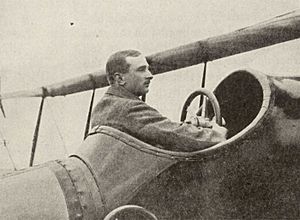Charles Collet facts for kids
Quick facts for kids
Charles Herbert Collet
|
|
|---|---|

C. H. Collet sat in his DFW Mars ca.1914
|
|
| Born | 4 February 1888 Calcutta, India |
| Died | 19 August 1915 (aged 27) Imbros, Turkey |
| Buried |
Lancashire Landing Cemetery, Turkey
|
| Allegiance | United Kingdom |
| Service/ |
Royal Navy |
| Years of service | 1905–1915 |
| Rank | Flight Lieutenant |
| Unit | Royal Marine Artillery Royal Naval Air Service |
| Battles/wars | World War I • Western Front • Gallipoli Campaign |
| Awards | Distinguished Service Order |
Flight Lieutenant Charles Herbert Collet DSO (born February 4, 1888 – died August 19, 1915) was a brave British naval pilot during the First World War. Many people thought he was one of the best naval airmen of his time.
Early Life and School
Charles Collet was born in India. His father, James Francis Herbert Collet, was an engineer. For a while, his family lived on an island called Guernsey. Charles went to school at Dulwich College. When he died, his parents were living in West End, near Southampton.
Charles Collet joined the Royal Marine Artillery as a second lieutenant on September 1, 1905. He became a lieutenant on July 1, 1906. On October 21, 1913, he earned his Aviators' Certificate No. 666. This meant he was officially a trained pilot! He got it after flying an Avro biplane at the Central Flying School in Upavon.
When World War I started on August 4, 1914, Collet was at RNAS Eastchurch. A few days later, on August 10, he joined a race called the "Circuit of Britain." This race was still held even though the war had begun. He flew a German plane called a DFW Mars. It had been bought by the Royal Naval Air Service (RNAS) and fitted with a new engine.
During the race, his plane had mechanical problems. He had to make an emergency landing at a racecourse in Scarborough. There, he was questioned by local police. After his plane was fixed, Collet finished the race and came in second place.
Collet's group, led by Wing Commander Charles Rumney Samson, first flew patrols along the North Sea coast. On August 27, 1914, they moved to France. His group was renamed No. 3 Squadron RNAS. They were based near Dunkirk and used different types of aircraft and even some homemade armored cars.
The Düsseldorf Air Raid
On September 22, 1914, Collet led a very important mission. He flew a Sopwith Tractor Biplane as part of a group of four planes. Their goal was to fly 200 miles to attack the Zeppelin sheds in Düsseldorf and Cologne, Germany. This was the first British air raid of the war!
There was a lot of thick mist in the Rhine Valley. Because of this, only Collet was able to find his target. He flew very low, only about 400 feet above the ground. He accurately dropped two 20-pound bombs on the Zeppelin shed in Düsseldorf. However, the bombs did not explode. Even though his plane was hit by enemy fire, he returned safely. The other three planes spent over an hour trying to find their targets in Cologne but couldn't. They returned without dropping their bombs.
Collet's brave flight was described like this:
- Flight Lieutenant Collet flew towards the Zeppelin shed in Düsseldorf from 6,000 feet up.
- He flew through a layer of mist and came out of it at only 400 feet above the ground.
- His target was very close.
- He flew very fast and dropped his bombs with great accuracy.
- He disappeared into the mist before the enemy even realized what was happening.
For his bravery, Charles Collet was given the Distinguished Service Order on October 21, 1914. This is a very important award for military officers.
On February 23, 1915, he was made a temporary captain while leading a flight. The very next day, he was promoted to flight lieutenant. He was also mentioned in official reports twice for his good work.
In March 1915, his group moved from France to the island of Tenedos. They went there to join the Gallipoli campaign. Their job was to fly reconnaissance (looking for enemy positions) and bombing missions over Turkish areas. On June 22, Collet was flying a Voisin plane with Major R.E.T. Hogg as his observer. They spotted a German plane near Achi Baba. Major Hogg shot at it with a rifle, hitting its engine. This forced the German plane to land.
Death
On August 19, 1915, Charles Collet took off from an airfield on Imbros island. He had reached a height of about 150 to 185 feet when his engine suddenly stopped working. Collet tried to turn his plane around to land. But strong winds from nearby cliffs made him lose control. His aircraft fell straight down to the ground and caught fire.
His passenger, Chief Petty Officer Michael Sullivan Keogh, was badly hurt. He broke his thigh in the crash. Even with his injuries, he bravely pulled Collet from the burning plane. Keogh suffered severe burns himself. Sadly, Collet was too badly injured and died about 30 minutes later. Keogh was given the Albert Medal (2nd Class) for trying to save Collet's life. Charles Collet is buried at the Lancashire Landing Cemetery in Turkey.
Other Achievements
Charles Collet was also the first naval officer to perform a "loop the loop" in an airplane. This is an aerobatic maneuver where the plane flies in a complete circle in the air.

